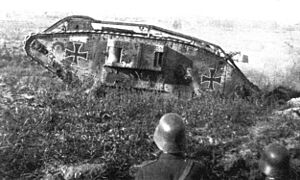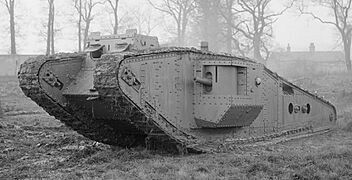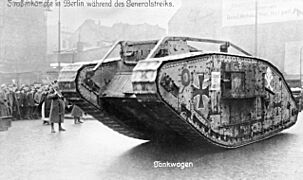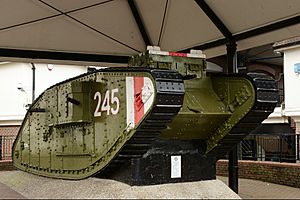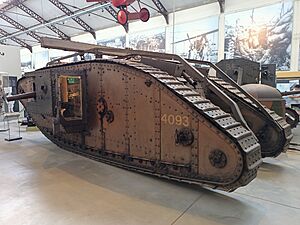Mark IV tank facts for kids
Quick facts for kids Mark IV |
|
|---|---|

A Mark IV "Male" tank showing off its unditching beam, a special tool to help it get unstuck.
|
|
| Type | Heavy tank |
| Place of origin | United Kingdom |
| Service history | |
| Used by | British Army Imperial German Army (captured tanks) Reichswehr (German army after WWI) Imperial Japanese Army |
| Wars | First World War German Revolution of 1918–19 |
| Production history | |
| Designer | |
| Manufacturer | see text |
| Unit cost | about £5,000 (a lot of money back then!) |
| Produced | May 1917 – end 1918 |
| No. built | 1,220 |
| Specifications | |
| Mass | 28 tons (28.4 tonnes) – that's like 20 medium-sized cars! Female: 27 tons (27.4 tonnes) |
| Length | 26 ft 5 in (8.05 m) |
| Width | Male: 13 ft 6 in (4.12 m) |
| Crew | 8 people |
|
|
|
| Armour | 0.5 inches (12 mm) thick |
|
Main
armament |
Male: Two 6-pounder (57-mm) 6 cwt QF guns with 332 bullets Female: five .303 Lewis guns (a type of machine gun) |
|
Secondary
armament |
Male: Three .303 in Lewis guns |
| Engine | Daimler-Foster, 6-cylinder in-line sleeve valve 16 litre petrol engine 105 horsepower (bhp) at 1,000 rpm |
| Transmission | Primary: 2 Forward gears, 1 Reverse gear Secondary – 2 speed |
| Fuel capacity | 70 Imperial gallons |
|
Operational
range |
35 mi (56 km) (how far it could go on one tank of fuel) |
| Maximum speed | 4 mph (6.4 km/h) (about as fast as a quick walk) |
The Mark IV (you say it "Mark four") was a very important British tank used in the First World War. It first appeared in 1917 and was a big improvement on the earlier Mark I tank. The designers learned a lot from the first tanks, which were mostly used for practice.
The Mark IV had stronger armour to protect the crew inside. They also moved the fuel tank to a safer place and made the tank easier to move from one place to another. The armour was made thicker to stop German bullets that could pierce through older tanks. The parts that made the tank move (the drivetrain) were also made stronger. A clever new feature was that the side gun turrets, called sponsons, could be swung inside the tank. This made the tank thinner so it could be carried on trains. Before this, the sponsons had to be taken off and moved by trucks, which took a lot of time.
In total, 1,220 Mark IV tanks were built. This included 420 "Males" (which had cannons and machine guns), 595 "Females" (which had only machine guns), and 205 Tank Tenders. Tank Tenders were unarmed tanks used to carry supplies like fuel and ammunition. Because so many were made, the Mark IV became the most common British tank of World War I.
The Mark IV tanks were first used in a major way in mid-1917 at the Battle of Messines Ridge. They continued to be used by the British Army until the war ended. After the war, a few were used for a short time by other countries.
Contents
How Was the Mark IV Tank Designed?
Albert Gerald Stern, who was in charge of getting tanks supplied, originally wanted the Mark IV to have a brand new engine and transmission (the parts that send power to the tracks). He even stopped the production of battle tanks until this new design was ready. This meant that older tanks, the Mark II and Mark III, had to be used for training soldiers.
However, making the new engine and transmission took too long. Stern needed to have 200 tanks ready by April 1, 1917, but he couldn't meet this deadline. So, in May 1917, he had to put the Mark IV into production with only small changes from the Mark I tank.
The Mark IV "Male" tank had quite a bit of firepower. It carried three Lewis machine guns. One was at the front of the cab (where the driver sits), and one was in each sponson (the gun pods on the sides). Each sponson also had a QF 6-pounder cannon. The barrels of these cannons were made shorter because the original long barrels would often hit things or dig into the ground.
The sponsons weren't exactly the same on each side. This was because the soldier aiming the 6-pounder gun (the gun-layer) operated it from the left side, while another soldier (the loader) put ammunition in from the right. The cannons could turn to shoot in a wide area (a 100-degree arc), but only the cannon on the right side (starboard) could fire straight ahead. The "Female" Mark IV tanks had five Lewis machine guns but no 6-pounder cannons.
The army decided to use Lewis guns in the tanks because they fit better in the small space inside. The Lewis gun's barrel could be easily damaged, and it sometimes got too hot or jammed if fired for a long time. But it had a big advantage: it used round pan magazines that could hold up to 96 bullets. Another machine gun, the Hotchkiss, used stiff strips of metal to hold bullets. For tank use, these strips were cut down to hold only 14 rounds. This meant that just as the gunner got aimed, they'd have to change the strip! Later, in May 1917, a flexible 50-round strip was developed for the Hotchkiss, and it became the main machine gun for tanks again. These changes caused some delays, like redesigning parts to fit the bulky cooling barrel of the Lewis gun.
Special Equipment for Crossing Trenches
At the Battle of Cambrai in 1917, Mark IV tanks were given special equipment called fascines. These were big bundles of brushwood (small branches and sticks) tied together with chains. They were about 10 ft (3.0 m) long and 4 ft 6 in (1.37 m) thick and were carried on the roof of the tank's cab. When the tank came to a wide trench, the crew would drop the fascine into it. This helped the tank cross over the trench more easily.
Many Mark IVs were also used for trying out new ideas. To help tanks cross trenches even better, engineers invented the "tadpole tail." This was an extension added to the back of the tracks. But it wasn't strong enough and probably wasn't used in actual battles. Other experiments included testing radios, putting mortars (small cannons that fire shells high in the air) between the rear horns of the tank, and adding recovery cranes to lift heavy things. Some of these ideas were later used on tanks in service. Mark IVs were also the first tanks to be fitted with "unditching beams" by army workshops. This was a large wooden beam, made stronger with metal sheets, stored on top of the tank. If a tank got stuck in mud, the crew would attach the beam to the tracks (often while under enemy fire!). The tracks would then pull the beam underneath the tank, giving it something to grip on and get free.
Key Features of the Mark IV
Here are some quick facts about the Mark IV:
- Crew: 8 soldiers
- Weight in Battle:
- Male: 28 tons (28.4 tonnes)
- Female: 27 tons (27.4 tonnes)
- Armour Thickness: 0.25–0.47 inches (6.1–12 mm)
- Weapons (Armament):
- Male: Three machine guns and two 6-pounder cannons
- Female: Five .303 Lewis light machine guns
- Ammunition Carried: For the 6-pounder cannons, 180 High Explosive (HE) rounds, plus other types.
Who Built the Mark IV Tanks?
The Mark IV tanks were built by six different companies:
- Metropolitan (this company built the most)
- Fosters of Lincoln
- Armstrong-Whitworth
- Coventry Ordnance Works
- William Beardmore & Company
- Mirrlees, Watson & Co.
Most of the production happened in 1917. The first big order for 1,000 tanks was given to Metropolitan in August 1916. This order was changed a few times between August and December 1916. The other companies, which were asked to build no more than 100 tanks each, weren't as affected by disagreements between Mr. Stern (from the Tank Supply Department) and the War Office (the government department in charge of the army).
The Mark IV Tank in Action
The Mark IV tanks were first used in large numbers on June 7, 1917. This was during a British attack on a place called Messines Ridge. The ground was dry but full of craters from bombs and shells. Many of the 60-plus Mark IVs had trouble keeping up with the soldiers on foot, but some of them played an important part in the battle.
Later, at the Third Battle of Ypres (also known as Passchendaele), which started on July 31, things were different. Before this battle, there had been 24 days of non-stop artillery bombing. This destroyed all the drains in the area, and then heavy rain soaked the battlefield, turning it into a muddy swamp. The tanks found it very hard to move in these conditions and didn't help much. Many tanks sank into the swampy ground, got stuck, and became easy targets for enemy cannons.
Nearly 460 Mark IV tanks were used during the Battle of Cambrai in November 1917. This battle showed that a large group of tanks working together could break through even the strongest enemy trench systems very quickly.
In April 1918, after the Germans launched a big attack called the German spring offensive, the first battle between tanks happened. This was during the Second Battle of Villers-Bretonneux, where British Mark IV tanks fought against German A7V tanks.
About 40 captured Mark IVs were used by the German army. They called them Beutepanzerwagen (the German word Beute means "loot" or "booty," like treasure taken from an enemy). These captured tanks had a crew of 12 soldiers and were organized into four tank companies starting in December 1917. On some of these tanks, the British 6-pounder cannons were replaced with similar German guns.
The very last Mark IV to be used in service, for a very short time, was a Male tank named Excellent. It was kept by a naval gunnery school called HMS Excellent on Whale Island in Portsmouth harbour. In 1940, during World War II, it was fixed up to working order and driven to the mainland. People say its new job ended quickly after it accidentally damaged a car!
Where Can You See Mark IV Tanks Today?
Even though World War I ended long ago, some Mark IV tanks still exist and you can see them in museums:
- A Mark IV Female tank that fought at the Battle of Cambrai is at the Museum of Lincolnshire Life in Lincoln. A local company, William Foster & Co., made the first tanks. However, since the only Mark IVs built in Lincoln were Male tanks, this one was probably built by Metropolitan in Birmingham. Recently, a part of a serial number was found on this tank, which makes people wonder if it's really the tank named Flirt II, as it used to be called.
- A Mark IV Female is kept in the town of Ashford in Kent, England. After the war, many tanks like this were given to towns and cities in Britain to put on display. Most of them were scrapped (taken apart for metal) in the 1920s and 1930s. The engine of this tank was once removed to put an electricity substation inside it! That was later taken out, leaving the inside empty.
- The Royal Museum of the Armed Forces in Brussels, Belgium, has a Male Mark IV tank called Lodestar III. It is still in its original paint colours.
- A Mark IV Female tank named Grit is owned by the Australian War Memorial. It is put on display every year at their open day event.
- A Mark IV Male tank named Excellent (the same one mentioned earlier!) is displayed at The Tank Museum in Bovington Camp, England. This tank was given by the army to HMS Excellent, a Royal Navy base where some tank crews were trained during World War I. It was briefly made to run again in 1940 to help defend Britain, but it didn't actually fight. It was given to the Tank Museum in 1971.
- Mark IV Female Liberty: This tank is stored at Anniston Army Depot in Anniston, Alabama, USA. After being outside in all kinds of weather for many years, it's in poor condition. But it's now at the Armor Restoration Shop at Fort Benning, Georgia, where it is being kept safe before it can be restored.
- A Mark IV Female tank, D51, known as Deborah, was dug up from the ground in the village of Flesquières in France in 1999. It had been knocked out by enemy shell-fire during the Battle of Cambrai and was later buried when it was used to fill a big hole (a crater). Deborah was badly damaged and rusty when it was found, but it has been treated to stop it from getting worse. It is now in a small museum in Flesquières, near the graves of some of its crew members.
See also
- Mark V tank (The tank that came after the Mark IV)
- Steam tank: An American tank design that didn't work out so well. It was based on the Mark IV but used steam power and had a flamethrower.



